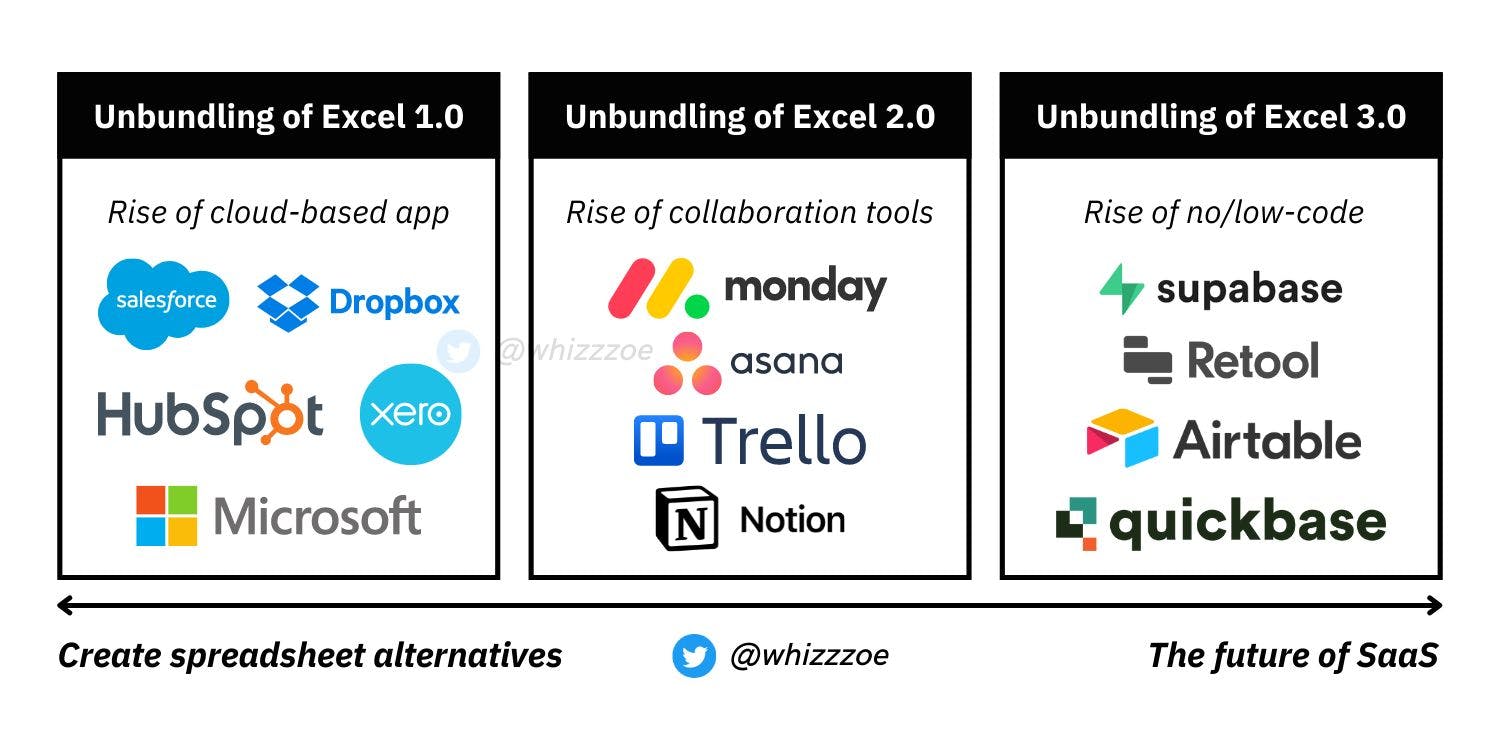Note: This article is part of my resource newsletters↗️ where I share insights on building things in tech. Join me :)
👋 I’m Zoe Chew, a product builder. I’ve built multiple apps using the rapid MVP method: sneaker app, personal FAQ, meal kit app, virtual event app, SaaS tracker, food delivery, content app +more
I’m on a quest to understand the future of the Internet. Each week, I analyze profitable industries, and how you can compete and monetize—at the intersection of Internet platforms & consumer tech.
Today’s post is about the future of SaaS. Read here if you’re interested in the Web3 creators economy, future of social networks, FinTech & wellness tech, or B2C online marketplaces.
1. Excel is SaaS’s Biggest Competitor
In a pre-SaaS (software-as-a-service) world, nearly every industry relied on Microsoft Excel. Accountants relied on it for finance management. Managers used it for project management. HR used it for payrolls and employee directories. The sales team used it for lead management and CRM. Individuals used it for to-do list planning.
As companies adopt digitization, operations and workflows become more complicated. Businesses need to find a way to automate and scale efficiently. Teams need to collaborate internally and externally. Specific use cases gave rise to the unbundling of Excel—businesses are created to replace spreadsheets with alternative tools that cater to a niche target audience, interest, and job-to-be-done.
2. Turning Excel Templates into Software Companies
Despite new players arise, Excel has yet to be completely replaced due to its decade-long usage, programming capabilities (i.e., Excel formula), and reliability.
In fact, most SaaS apps are simply products unbundled from Excel. These are businesses that turn spreadsheets into profitable software companies:
- Salesforce, one of the earliest SaaS businesses founded in 1999 replaced CRM spreadsheets in Excel
- Trello, Jira, and Asana replaced project management and Gantt chart Excel templates
- Xero, QuickBooks replaced bookkeeping in spreadsheets
- (📥 Full version) 3 more business categories are born out to replace Excel templates
- (📥 Full version) 14 more company examples across business categories
3. Unbundling of Excel: Era 1.0, 2.0 and 3.0
To understand the future of SaaS, we need to zoom into the transition of Excel unbundling. I call it Excel 1.0, 2.0, and 3.0 of Excel unbundling:
- Unbundling of Excel 1.0: The Internet was born. Rise of cloud-based apps such as cloud-based CRM (Salesforce, Hubspot), document management (Dropbox, Google Drive, Microsoft Online), and cloud accounting (Xero). Softwares are created to replace spreadsheet functionalities with a better interface, user experience, integration, and workflow optimization.
- Unbundling of Excel 2.0: Rise of collaboration tools. Softwares are created to empower team collaboration. For example, project management (Trello, Asana), document collaboration, communication tools. (📥 Full version) 9 more company examples across segments.
- Unbundling of Excel 3.0: Rise of no-code, low-code tools. Softwares are created to turn spreadsheets into apps without any technical knowledge. Airtable & Coda turns spreadsheets into interactive databases. Glide, Adalo turns spreadsheets into mobile apps. (📥 Full version) 5 more company examples across segments.
4. What Problems Do They Solve?
- Break down technical barriers. No-code and low-code tools empower non-technical developers to build websites, apps, automated workflow, and infrastructure.
- Reduce blockers. Most team collaboration apps solve this problem by allowing internal collaboration within an organization.
- (📥 Full version) 3 more valid problems existing players are solving. Understand these problem statements will help you build something people want. You’ll also learn:
- Problem definition 1: What problems does Firebase solve?
- Problem definition 2: What problems do collaboration apps solve?
- Problem definition 3: What problems do low-code apps solve?
5. Business Models
A SaaS typically makes money through a monthly or yearly recurring subscription membership model by providing access to the product features. There are different ways to charge access for users, for example:
- Usage-based pricing: Charging for additional tasks, workflows, and API calls. Common in automation tools, i.e. Zapier, Parabola, Integromat, Paragon.
- (📥 Full version) 4 more strategies to help you layer different revenue streams and build a profitable SaaS. You’ll also learn:
- Strategy 1: If you’re just starting out with a SaaS MVP, you can monetize immediately using this pricing model, then add more revenue layers as you go.
- Strategy 2: If you want to scale the pricing, this model is a good addition.
- Strategy 3: If you’re creating a SaaS for creators monetization, this is a strategic business model.
- Strategy 4: Most common way to create additional revenue streams on top of your core SaaS features.
6. Why Now?
There are massive opportunities to build in the SaaS space. This section explores the key takeaways, the future of SaaS, and the “why now” questions (most important slide in a pitch deck!) for your investors:
- To compete in today’s SaaS world, it’s not enough to create a SaaS business by offering better UI and UX. Customers have rising expectations—does it offer automation? Integration? Speed? API? All-in-one feature for the price of one?
- (📥 Full version) 4 more market evidence in detail to help you answer the “why now” questions. You’ll also learn:
- Evidence 1: new problems that are emerged from remote work and why new SaaS solutions are needed
- Evidence 2: new problems that are emerged from freelancing entrepreneurship and why it matters for SaaS businesses
- Evidence 3: why this cultural shift in the workplace will give rise to new SaaS solutions?
- Evidence 4: where the future of SaaS is heading?
Business Opportunities
- (📥 Full version) 3 specific product ideas and business opportunities that are solving problems. You’ll unlock:
- Opportunity 1: SaaS idea that helps cross-functional teams collaborate
- Opportunity 2: SaaS idea that helps product team build the right product features
- Opportunity 3: SaaS idea in automation
👉 Get the full report here:
[2] Weekly market insights in your inbox — Click here to join my newsletter 💌
Also Published At: https://whizzoe.substack.com/p/unbundling-of-excel-and-the-future


